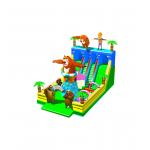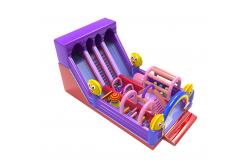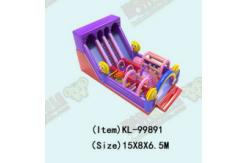Inflatable Slides
This is an inflatable playground. It features a purple and red
structure with two parallel slides in the center. The slides are
blue and have red steps on them. Surrounding the slides are various
colorful elements, including pink arches, a rainbow arch in blue
and red, and some yellow decorations with smiling faces. There are
also red and orange striped cylinders and other playful structures.
This inflatable playground looks like a fun place for children to
play and enjoy.
Specifications:
| Material | PVC Tarpaulin |
| Size | 15*8*6.5m or Customize |
| Color | As the picture shown or customized |
| Printing | Drawing printing |
| Package | Strong PVC bag for inflatables, carton for blower |
| Accessories | Blower, repair kit (spare material and glue) |
| Blower | CE:220-240V UL: 110-115V |
| OEM | available |
| Workmanship | Double Stitching |
| Certificates | CE, SGS, EN14960 |
| Set uptime | About 10 mins, depend on the Amusement park size |
| MOQ | 1 PC |
| Payment | T/T, 30% deposit and 70% balance when shipment |
| Shipment | By sea, by air or by express |
| Warranty | 24 months |
| Application | Outdoor and indoor amusement for kids and adults |
Safety Measures for Inflatable Slides in Use
I. Installation and Placement
Ground Quality and Clearance
The ground where the inflatable slide is placed must be level and
free of sharp objects. Stones, branches, and broken glass can
puncture the slide's material, leading to air leakage. Grasslands
that have been groomed and cleared of debris or flat paved areas
like playgrounds or event spaces are preferable.
A buffer zone of at least 2 - 3 meters should surround the slide.
This ensures that there are no poles, trees, or other obstructions
in the vicinity. The buffer helps protect users from colliding with
objects outside the slide while they're sliding.
Avoid installing the inflatable slide in windy areas. Strong winds
can cause the slide to move, it, shift, or even be blown down. This
can cause serious accidents and endanger the safety of users.
Installation Checks and Inflation Test
When installing the inflatable slide, follow the manufacturer's
instructions carefully. Check all the connection points, especially
the junction between the slide and the inflatable base, to make
sure they're secure. Also, check if the inflation device is working
properly and if the air inlets and outlets are clear.
After the initial installation, do a trial inflation to check the
airtightness of the slide. Observe it for a while to see if there
are any leaks. If the slide doesn't hold air well, it won't be
atisfactory for users.
II. During Use
User Limitations and Assistance
The age and weight of users must be within the limits set by the
inflatable slide. Different models of slides have different
load-bearing capacities and suitable age ranges. For example, a
small slide might be suitable for children aged 3 - 6 with a weight
limit of less than 30 kilograms; a large slide could allow older
children and adults to use it, but there will also be an upper
weight limit, such as about 100 kilograms. Exceeding these limits
can damage the slide and put users at risk.
For younger children, having an adult with them is a good idea.
Toddlers may need help climbing the steps and sliding down safely.
In case of an accident, the adult can provide immediate protection.
Clothing and Footwear Requirements
Users should wear appropriate clothing. Avoid clothes with sharp
parts like metal zippers, buttons, or hard plastic decorations.
These can scratch the slide and cause air leaks. Soft, flexible
clothes like sportswraw are better.
When it comes to shoes, don't wear flip-flops or high heels. These
can come off easily or make it hard to move. Instead, choose
sneakers or flat shoes that give you good traction.
Prohibited Actions during Use
Pushing, shoving, and roughhousing on the slide are not allowed.
Users must queue up and to wait their turn when climbing the stairs
and sliding. Pushing can make someone lose balance and get
seriously injured.
The correct way to slide is face up and feet down. Sliding
headfirst or sideways is dangerous and can cause neck, shoulder, or
body injuries. Also, you can't reverse on the slide because it can
cause collisions with other users.
III. Maintenance and Supervision
Ongoing Safety Supervision
A dedicated supervisor should be assigned to oversee the use of the
inflatable slide. This person should constantly monitor the actions
of users and the state of the slide. Since multiple people can use
the slide at the same time, there can be unexpected problems like
improper use or small shifts in the slide's position. A vigilant
supervisor can detect and address these problems quickly.
The supervisor should position themselves in a location that
provides a clear view of the slide, typically on one side or at a
slightly elevated position, avoiding blind spots. At the same time,
they must take care to protect themselves from being hit by sliding
users.
Emergency Response and First Aid
The supervisor must have basic first aid knowledge. During the use
of the inflatable slide, minor accidents like scrapes and sprains
can happen. The supervisor should know how to clean, disinfect, and
bandage wounds. A first aid kit should be placed near the slide,
with items like adhesive bandages, disinfectant wipes, gauze pads,
and pain relievers.
In the event of a more than serious accident like a fracture,
severe bleeding, or unconsciousness, the supervisor should
immediately call emergency services and, while waiting for the
ambulance, try to do the right first aid measures like immobilizing
the fractured limb and applying fatection to the bleeding area.
FAQ
Q: How to repair when damage?
A:
Step 1: Identify the Damage
Thoroughly inspect the inflatable to locate any tears, punctures,
or leaks.
Step 2: Clean and Dry the Area
Clean the damaged area with mild soap and water to remove dirt or
debris. Allow the area to dry completely before proceeding with the
repair.
Step 3: Patch the Damage
Apply a patch specifically designed for inflatable repairs over the
damaged area. Make sure the patch is slightly larger than the
damaged area to ensure proper coverage. Press the patch firmly onto
the surface, smoothing out any wrinkles or air bubbles.
Step 4: Apply Adhesive
If using a patch that requires adhesive, apply a thin, even layer
of adhesive to both the patch and the inflatable surface. Allow the
adhesive to become tacky before pressing the patch onto the
surface.
Step 5: Allow Time to Cure/Allow the Adhesive to Dry
Once the patch is in place, you'll need to allow the adhesive to
dry completely. This may take several hours, depending on the type
of adhesive you are using. It's important to avoid using the
inflatable until the adhesive is completely dry, as this could
cause the patch to come loose. Wait at least 1 hour before
inflating again.
Step 6: Test the Repair
Once the patch has cured, inflate the inflatable and check for any
signs of leakage. If the repair holds, the inflatable is ready to
be used again.
It's important to use repair materials specifically designed for
inflatables and follow the manufacturer's instructions carefully to
ensure a successful repair. If the damage is extensive or beyond
your ability to repair, consider seeking professional assistance.
-
Q: Accessories included?
A: Free accessories include Storage Bag / Repair Kit / Warning
Label / Custom Logo .








